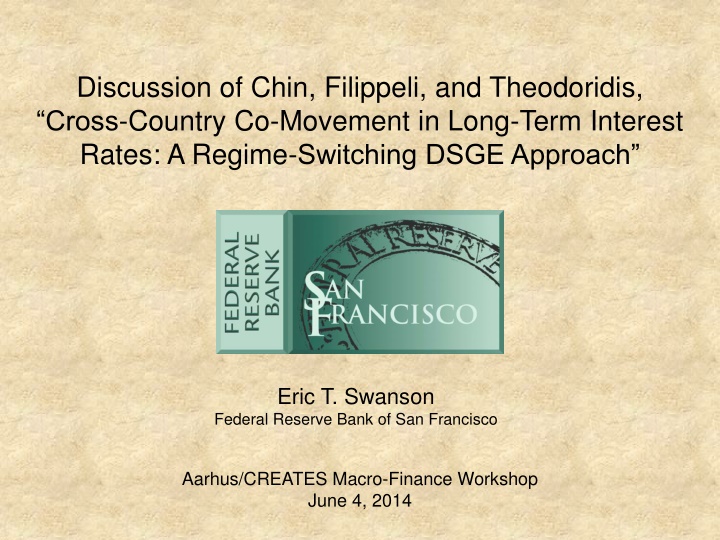
Modeling Co-Movement in Long-Term Interest Rates with Regime-Switching DSGE Approach
Explore the discussion on cross-country co-movement in long-term interest rates using a regime-switching DSGE model. The study delves into a two-country open economy macro model with financial intermediaries, adjustment costs, and co-movement mechanisms. Discover the impacts on US and UK long rates, adjustment costs, and market forecasts.
Download Presentation

Please find below an Image/Link to download the presentation.
The content on the website is provided AS IS for your information and personal use only. It may not be sold, licensed, or shared on other websites without obtaining consent from the author. If you encounter any issues during the download, it is possible that the publisher has removed the file from their server.
You are allowed to download the files provided on this website for personal or commercial use, subject to the condition that they are used lawfully. All files are the property of their respective owners.
The content on the website is provided AS IS for your information and personal use only. It may not be sold, licensed, or shared on other websites without obtaining consent from the author.
E N D
Presentation Transcript
Discussion of Chin, Filippeli, and Theodoridis, Cross-Country Co-Movement in Long-Term Interest Rates: A Regime-Switching DSGE Approach Eric T. Swanson Federal Reserve Bank of San Francisco Aarhus/CREATES Macro-Finance Workshop June 4, 2014
Model Overview Two-Country New Open Economy Macro Model Monopolistic Domestic Producers Monopolistic Importing firms Monopolistic Exporting firms Monopolistic labor supply Markup shocks to all of these plus shocks to G, i and two shocks to household preferences and two shocks to bond values In addition, two new features: Financial Intermediaries Regime switching
Financial Intermediaries Financial Intermediaries take deposits Buy short- and long-term government bonds and long-term foreign government bonds Maximize profits But there are adjustment costs to changing bond holdings Breaks the link to the Expectations Hypothesis Compare to Andres-Lopez-Salido-Nelson (2004), Chen-Curdia-Ferrero (2012)
Adjustment Costs Costs of adjusting short-term relative to long-term bonds: Costs of adjusting foreign debt holdings relative to GDP:
UK Long Rates Respond Strongly to US News Swanson-Williams (2014)
But the Mechanism is Unclear A rise in long-term U.S. interest rates causes U.S. long-term bond prices to fall Financial intermediaries balance sheet: Adjustment costs: To generate co-movement, exchange rate q must be playing an important role
Regime-Switching Doesnt Seem to Add Much Basic model is already very complicated And fits the data very well Marginal Likelihood of the regime-switching model is very close to the baseline model Why not drop it?
Summary of Comments & Suggestions Drop Regime-Switching Main point of the paper is the co-movement between US and UK long-term rates Focus on the mechanism driving this correlation If the mechanism is related to the exchange rate, is there any evidence for this in the data?
